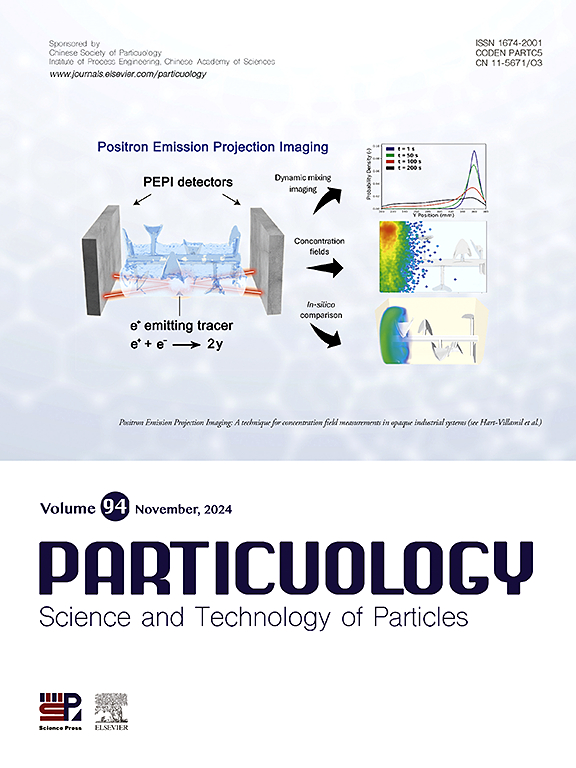A novel energy-efficient way to prepare solid lipid microspheres loaded with nanoscale drugs by combining LLPS and in-situ crystallization
IF 4.1
2区 材料科学
Q2 ENGINEERING, CHEMICAL
引用次数: 0
Abstract
In this work, API nanoscale drugs loaded onto solid lipid microspheres (ND@SLMs) were successfully prepared by combining in-situ crystallization technology and liquid-liquid phase separation (LLPS). This method is characterized by its low energy consumption and the absence of a requirement for high concentrations of surfactants. Tristearin (SSS) was used as the drug carriers, and fenofibrate (FEN) was used as API to verify the feasibility of this method. Characterization was performed using SEM, PXRD, and DSC, while in-situ Raman and EasyViewer enabled real-time monitoring of the particle formation process. The results show that the obtained Active Pharmaceutical Ingredient (API) nanoscale crystals exhibited uniform distribution in the solid lipid carrier and enhanced release rates compared to the bulk ingredients. API droplets prepared by LLPS adhered to the surface of the FEN + SSS droplets played the role of dispersant. Response surface analysis was employed to analyze the independent variables and their interactions, and the optimum value of the processing parameters was obtained. Finally, the expandability of this method to other hydrophobic drugs was verified by ibuprofen (IBU).

采用LLPS和原位结晶相结合的新型高效制备纳米级药物固体脂质微球
本研究通过原位结晶技术和液-液相分离技术(LLPS)相结合,成功制备了载于固体脂质微球(ND@SLMs)上的原料药纳米级药物。该方法的特点是能耗低,不需要高浓度的表面活性剂。以硬脂酸酯(SSS)为药物载体,非诺贝特(FEN)为原料药,验证该方法的可行性。利用SEM、PXRD和DSC进行表征,同时利用原位拉曼和EasyViewer对颗粒形成过程进行实时监测。结果表明,所制得的活性药物成分(API)纳米级晶体在固体脂质载体中分布均匀,与原料药相比,其释放速度加快。由LLPS制备的API液滴粘附在FEN + SSS液滴表面,起到分散剂的作用。采用响应面分析法对各自变量及其相互作用进行了分析,得到了工艺参数的最优值。最后,用布洛芬(ibuprofen, IBU)验证了该方法对其他疏水药物的可扩展性。
本文章由计算机程序翻译,如有差异,请以英文原文为准。
求助全文
约1分钟内获得全文
求助全文
来源期刊

Particuology
工程技术-材料科学:综合
CiteScore
6.70
自引率
2.90%
发文量
1730
审稿时长
32 days
期刊介绍:
The word ‘particuology’ was coined to parallel the discipline for the science and technology of particles.
Particuology is an interdisciplinary journal that publishes frontier research articles and critical reviews on the discovery, formulation and engineering of particulate materials, processes and systems. It especially welcomes contributions utilising advanced theoretical, modelling and measurement methods to enable the discovery and creation of new particulate materials, and the manufacturing of functional particulate-based products, such as sensors.
Papers are handled by Thematic Editors who oversee contributions from specific subject fields. These fields are classified into: Particle Synthesis and Modification; Particle Characterization and Measurement; Granular Systems and Bulk Solids Technology; Fluidization and Particle-Fluid Systems; Aerosols; and Applications of Particle Technology.
Key topics concerning the creation and processing of particulates include:
-Modelling and simulation of particle formation, collective behaviour of particles and systems for particle production over a broad spectrum of length scales
-Mining of experimental data for particle synthesis and surface properties to facilitate the creation of new materials and processes
-Particle design and preparation including controlled response and sensing functionalities in formation, delivery systems and biological systems, etc.
-Experimental and computational methods for visualization and analysis of particulate system.
These topics are broadly relevant to the production of materials, pharmaceuticals and food, and to the conversion of energy resources to fuels and protection of the environment.
 求助内容:
求助内容: 应助结果提醒方式:
应助结果提醒方式:


